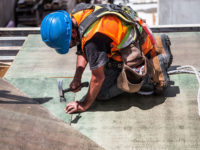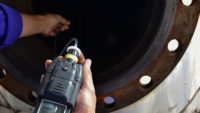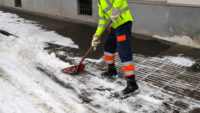Shade and clothing are the best defenses against the sun, but sunscreen is the next best choice. Workers should use water-resistant, broad-spectrum sunscreen with a sun protection factor (SPF) of 30 or higher and reapply it every 40 to 80 minutes. Broad spectrum coverage means it passed a test proving it protects against ultraviolet A (UVA) and ultraviolet B (UVB) rays, both of which can cause skin cancer. Bottles should be readily available, or workers can carry travel bottles, tubes, sticks or pouches to keep the sunscreen on their person.
It doesn’t matter how hot it is outside. The sun can be a danger to workers in any weather. Approximately one in five Americans will develop skin cancer in their lifetime. It’s crucial for workers to protect their skin from potential heat-related illnesses, which can include sunburn or skin cancer, when working outdoors by either covering their skin or wearing protective sunscreen that meets the recommendations laid out by the American Academy of Dermatology.
When choosing a sunscreen, it’s best to use one that has a SPF rating of 30 or more. Using sunscreen with a higher SPF doesn’t necessarily guarantee more protection. It should also be labeled “water resistant” or “very water resistant” to ensure it doesn’t rub off too easily. However, sunscreen is not waterproof and should be applied every 40 to 80 minutes through perspiration. Each person will need around one ounce of sunscreen every time they reapply.
While wearing SPF sunscreen is great, additional protection is always better.
Workers should consider wearing long sleeve shirts, pants, and a wide-brim hat as much as possible when working outdoors. Keep in mind though, that not all clothing is the same when it comes to sun protection. Some may have a UPF rating that can actually block a percentage of UV radiation. Companies can provide light moisture-wicking clothing as well as cooling devices and accessories. Evaporative cooling towels, vests, hard hat pads, and neck wraps/shades that have these properties can help keep the team comfortable in warmer temps.
Setting up a tent or flag for shade can also help reduce the team’s exposure to the sun. Try to minimize the amount of time workers need to be outside from 10 a.m. to 4 p.m., when the sun is at its strongest. If wearing this clothing or working in the shade isn’t possible, sunscreen is your best option for defense.
It bears repeating, sunscreen should be readily available throughout the workplace, so workers can reapply as needed. Using a bottle with a pump makes it easy for individuals to get more sunscreen. They don’t have to spend time squeezing the bottle. It should be kept in a centralized location with clear markings. They can also carry individual sunscreen packets when working in the field. Without easy access to sunscreen, workers will less likely use it.
Everyone should know when and how to apply sunscreen. Employers must inform workers of the risks of not using sunscreen and provide quality products that will protect outdoor workers.
Sunburns can be painful and inconvenient, but skin cancer can be fatal and lead to lifelong complications. Workers should refer to these guidelines to decrease their chances of injury when working in the sun.



